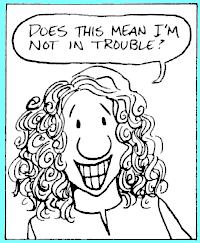
My niece bought a graphic novel for my daughter. It's called Digger and it is by someone called Ursula Vernon and I have never heard of it before or of her and that is a tragedy because she has written a masterpiece. But the thing is, even though this is the best graphic novel that I have read all year (edging out George O'Connor's Aphrodite just barely), there is a good chance you might not like it.
I think I love it for a bunch of reasons, but one of the first is that it connects a bunch of my interests. The main character is a wombat (I have loved wombats since I first saw one at Brookfield Zoo on a trip to Chicago when I was in grade school), he is an engineer (so is one of my best friends) , the story features intelligent trolls (the college where I teach has the troll as a mascot), and there are wonderfully bizarre characters like a slug that can tell the future by reading leaves, a medicine/woman/hag who is neither old nor hag-like, a shrew that thinks it is a troll, rats with wings, and a human guide who took the wrong herbal supplement and ended up with the head of a deer. So that stuff might all be stuff I connect with and you don't. But fortunately, that isn't all this book offers.
The writing is brilliant. In some sections she slips into first person narratives told through narration boxes with an incredibly strong voice to them (her writing skills are ridiculously well-demonstrated in one of the bonus stories in the back that describes a villager's interaction with Digger the wombat. The point-of-view is close to the villager, which allows the reader to draw conclusions about that is going on even before the villager does. But really, you would have to read it to really get a sense for it, but I think I can give you some idea with a couple of quotes taken out of context:
"Don't you know not to mess with a sleeping wombat? We swing pickaxes for twelve hours a day. We're like biceps with feet." (Digger, p. 23)
"He wants something, and I'll bet you diamonds to dolomitic conglomerates it's gonna involve us going back down that hole." (Digger 119)
"No one should have to explain cultural relativism on a queasy stomach, particularly since wombats aren't cultural relativists. We know full well that some stuff is just wrong." (Digger, p. 441)

The art is brilliant as well. Vernon's work is very careful. Every single line is necessary and conveys a great deal. At times it looks almost like a woodcut. Despite a minimum of lines, the expressions of the characters carry a ton of feeling and emotion. Between the text and the image, you begin to really care for many of the characters (and intensely dislike some of the others -- though often your allegiance shifts as you get to know more about them.
Like in Jeff Smith's Bone series (or Lord of the Rings for that matter), Vernon masterfully weaves a world that is strangely both like and unlike ours -- but which is fully and completely believable. Somehow an anthropomorphic wombat encountering violent fruit makes sense in the context of the tale.
Although this story first appeared in a bunch of different volumes, it hangs together when you read it all at once (though the omnibus edition is a little hard to read on the couch. It is so huge you almost need a table to put in on). It also has some powerful themes and ideas in it. Vernon herself states the theme of the book as "If you are reasonably polite and reasonably intelligent and work very hard, you should win in the end".(807) but it seems to me that sells the book short. It also deals with brokenness and the difficulty of making things right, about gender stereotyping and the stupidity of violence and how hard it is to figure out what is the right thing to do in some situations. Also redemption, how strength is not based on size or muscles, and how people who seems insane makes sense when you know their backstory.
Sounds interesting, you might say, but is it a children's' book? Is it written for adolescents? Honestly, I have no idea. I think reasonably intelligent middle school and high school students would love this book. There are three minor vulgarities that I noticed and there are some implied references to sex, but nothing graphic. My guess is that Vernon wrote this book for people and not specifically for children (just as Tolkien wrote Lord of the Rings) -- but sometimes I think the best books in the world are like that.
I have more to say, but really I want to suggest that if this sounds intriguing to you, you ought to buy the book. I'll let Digger have the last word.







